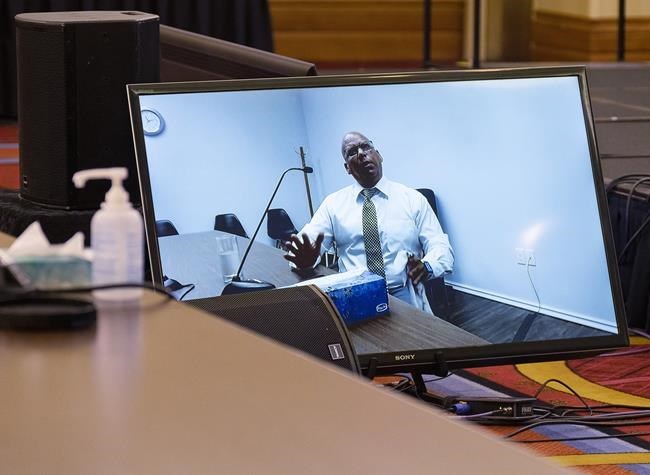HALIFAX — A former Mountie is standing by his account that challenges testimony the RCMP failed to respond to a domestic violence call in 2013 involving the Nova Scotia mass shooter.
Troy Maxwell, a retired RCMP constable, told a public inquiry Tuesday he had spoken with Brenda Forbes only about a claim that her neighbour, Gabriel Wortman, was driving recklessly around the community of Portapique, N.S., in a decommissioned police car and was "being belligerent."
Forbes, however, has testified before the inquiry that she told police that Wortman — responsible for killing 22 people on April 18-19, 2020 — had pinned his spouse, Lisa Banfield, to the ground in July 2013 with witnesses present and that nothing was done about it.
She has denied during her testimony that she merely called police to make a "disturbance" complaint about reckless driving, as Maxwell alleges.
The inquiry is attempting to sort through the conflicting accounts regarding details of the killer's domestic violence prior to the mass murder. Its mandate includes examining gender-based violence — and how it relates to the killings.
On Tuesday, Maxwell didn't back down from his April 29 interview with inquiry investigators, repeating that Forbes had called in a complaint to the RCMP that Wortman had been "tearing around" Portapique in an old police car at about 10 a.m. on July 6, 2013.
He testified that he gathered some information with a followup phone call to Forbes, took a few names down and drove to the community. Maxwell also testified that he believed he had seen a Ford Crown Victoria — a model of police car widely used until about 2011 — in Wortman's yard when he went to the killer's house at "dusk" that day to inform him of the complaint.
However, last Friday, Banfield testified that she and Wortman didn't own a decommissioned police vehicle in 2013. As well, the inquiry has said the killer only purchased four decommissioned Ford Taurus police vehicles in 2019.
Forbes has maintained her version of events. She told the inquiry that she had called RCMP and had later met with two police officers at her office in Debert, N.S., and told them that she had spoken to a witness who saw Banfield being pinned to the ground and choked by Wortman.
Banfield has confirmed the assault in her own testimony.
Maxwell told the inquiry Tuesday that Banfield's testimony doesn't change his version of what happened.
"I recall back in the day that they used to take the old Crown Victoria (police cars), strip them down and they would auction them off and you would see people driving around in (them)," he testified.
"There was in my mind definitely a Crown Vic in that (Wortman's) yard …. That's my recollection."
Asked by commission counsel Emily Hill if Forbes ever told him about the attack, he responded, "No, ma'am."
Also, in his version, Maxwell said he only visited Forbes in Debert after he investigated her complaint in Portapique. His memory is foggy on when exactly he carried out that visit. He said he went to Debert to inform her the investigation on the "disturbance" was being closed.
Meanwhile, Maxwell's memory about which officers — if any — accompanied him to Portapique to investigate what he claimed was a disturbance complaint, and to meet Forbes in Debert, has changed over the past two years.
The constable told an RCMP investigator in June 2020 that Const. Karl MacIsaac went with him to Debert in 2013 to meet with Forbes and that Cpl. Kenda Sutherland was with him in Portapique. However, he testified on Tuesday that his memory is now that MacIsaac had accompanied him to Portapique, while he had difficulty recalling who, if anyone, accompanied him to Debert.
The inquiry has said in summary documents that neither MacIsaac nor Sutherland had notes or specific memories about visiting the towns with Maxwell. The full police report on the July 6, 2013, response to Forbes's complaint was purged from police records in 2015.
Maxwell said the lack of a written record makes it difficult for him to explain why he wrote down the first name of Lisa Banfield, or the name of a witness to the assault — Glynn Wortman, the killer's uncle — in his notes.
"I'm going off nothing but my memory. You have to understand I can give you snippets, but as far as the file … I don't have that," he testified.
Joshua Bryson, a lawyer for the family of victims Peter and Joy Bond, asked Maxwell why he didn't seek statements from the people whose names he wrote down, before closing the file on the complaint.
Maxwell responded that he had other cases to pursue. "We don't have the ability to sit around and say, 'Oh yeah, we're going to spend an hour on this.'"
Bryson asked also about how Maxwell testified that he remembered knocking on the door of Wortman's Portapique residence at "dusk" in July after 7 p.m., when the constable's shift was recorded in notes as ending at 5 p.m.
Maxwell said he couldn't recall exactly when his shift ended that day, but he stood by his memory of visiting Portapique at a time when interior lights in neighbourhood houses were being turned on.
This report by The Canadian Press was first published July 19, 2022.
Michael Tutton, The Canadian Press




